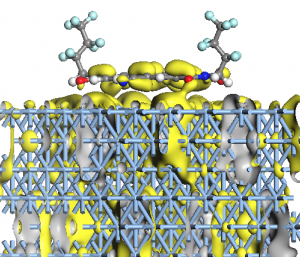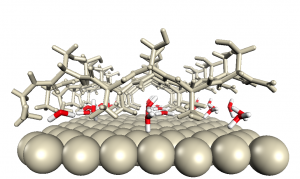This activity is dedicated to the ab initio study of physico-chemical characterization of molecular systems (especially magnetic molecules) and hybrid organic-molecule/inorganic-surface interfaces. Particular attention is devoted to the identification of interactions that may be controlled in order to impart specific properties to the interface, such as structural order of the adlayer, band engineering, doping, etc. Direct comparison with experiments is favored by the simulation of microscopies (e.g. STM) and spectroscopies (e.g. UPS, XPS, NEXAFS, optical absorption).
1. MOLECULAR RADICALS & SPINTERFACE
 This research field studies the modifications of magnetic properties of molecular magnets (both including metal ions and metal-free radicals) induced by the coupling with the substrate, for spintronics applications and quantum computing. A few systems of interest are: Fe(II) spin-crossover films on Au, molecular radicals (e.g. PTMTC, pyrene, blatter) on Au and TiO2, phthalocyanine on gold.
This research field studies the modifications of magnetic properties of molecular magnets (both including metal ions and metal-free radicals) induced by the coupling with the substrate, for spintronics applications and quantum computing. A few systems of interest are: Fe(II) spin-crossover films on Au, molecular radicals (e.g. PTMTC, pyrene, blatter) on Au and TiO2, phthalocyanine on gold.
Collaborations: B. Casu (Univ. Tubingen, GE), A. Rajca (Univ. Nebraska USA), J. Veciana and J. Vidal-Gancedo (ICMAB-CSIC Barcelona, ES), M. Pedio (CNR-IOM ed Elettra, Trieste)
Main References
[1] T. Junghoefer, A. Calzolari, I. Baev, M. Glaser, F. Ciccullo, E. Giangrisostomi,R. Ovsyannikov, F. Kielgast, M. Nissen, J. Schwarz, N. M. Gallagher, A. Rajca, M. Martins, M. B. Casu "Magnetic ordering in metal-free radical thin films", Chem. 8 1 (2022).
[2] S. Zhang, M. Pink, T. Junghoefer, W. Zhao, S.-N. Hsu, S. Rajca, A. Calzolari, B. W. Boudouris, M. B. Casu, and A. Rajca, High-Spin (S = 1) Blatter-Based Diradical with Robust Stability and Electrical Conductivity, J. Am. Chem. Soc. 144, 6059 (2022).
[3] V. Lloveras, P. Elías-Rodríguez, L. Bursi, A. R. Goñi, A. Calzolari, and J. Vidal-Gancedo, "Reversible electrochemical switch based on spin-labelled gold nanoparticles with optical and magnetic responses", NanoLett. 22, 768 (2022).
[4] T. Junghoefer, N. M. Gallagher, K. Kolanji, E. Giangrisostomi, R. Ovsyannikov, T. Chassé, M. Baumgarten, A. Rajca, A. Calzolari, M. B. Casu, "Challenges in controlled thermal deposition of organic diradicals", Chem. Mater. 33, 2019 (2021).
[5] F. Ciccullo, A. Calzolari, K. Bader, P. Neugebauer N. M. Gallagher, A. Rajca, J. van Slageren, and M. B. Casu, "Challenges in interfacing a potential purely organic molecular quantum bit with a real-life surface", ACS Appl. Mater. Int. 11, 1571 (2019).
[6] R. Kakavandi, A. Calzolari, Y. B. Borozdina, P. Ravat, T. Chassé, Martin Baumgarten, and M. B. Casu, "Unraveling the Mark of Surface Defects on a Spinterface: the Nitronyl Nitroxide/TiO2(110) interface", Nano Research 9, 3515 (2016).
[7] V. Mugnaini, A. Calzolari, R. Ovsyannikov, A. Vollmer, M. Gonidec, I. Alcon, J. Veciana, and M. Pedio, "Looking Inside the Perchlorinated Trityl Radical/Metal Spinterface through Spectroscopy", J. Phys. Chem. Lett. 6, 2101 (2015).
2. CHARGE INJECTION IN METALLIC INTERFACES
 The study deals with the bond formation and/or the charge redistribution at the interface between metal surfaces (e.g. Au, Ag, Cu) and organic semiconductors (e.g. pentacene, coronene, perylene) or coordination complexes (e.g. porphyrins, phthalocyanines), assumed as prototypical models for the characterization of electrode/molecule contacts in organic electronics. Other examples include the simulation of donor-acceptor pairs (e.g. ferrocene-spacer-gold SAM), which are at the core of the charge transfer processes in biological systems.
The study deals with the bond formation and/or the charge redistribution at the interface between metal surfaces (e.g. Au, Ag, Cu) and organic semiconductors (e.g. pentacene, coronene, perylene) or coordination complexes (e.g. porphyrins, phthalocyanines), assumed as prototypical models for the characterization of electrode/molecule contacts in organic electronics. Other examples include the simulation of donor-acceptor pairs (e.g. ferrocene-spacer-gold SAM), which are at the core of the charge transfer processes in biological systems.
Collaborations: B. Casu (Univ. Tubingen, GE), A. Cassinese (Univ. Federico II, Napoli, IT),D. Prezzi (CNR-NANO, IT), L. Floreano (CNR-IOM ed Elettra, Trieste), M. Caldas and H. Petrilli (Univ. de Sao Paulo, Brazil).
Main References
[1] J. Ritter, M. J. Caldas, T. da Silva, A. Calzolari, M. McCluskey, "Surface Effects on Pyrene Luminescence Excitations", ACS Appl. Elec. Mater. 2, 2806 (2020).
[2] P. Jacobson, D. Prezzi, D. Liu, M. Schied, J. Tour, S. Corni, A. Calzolari, E. Molinari, and L Grill, "Adsorption and Motion of Single Molecular Motors on TiO2(110)", J. Phys. Chem. C 124, 24776 (2020).
[3] F. Ciccullo, A. Calzolari, I. Píš, S.-A. Savu, M. Krieg, H. F. Bettinger, E. Magnano, T. Chassé, and M. B. Casu, "A quasi-free standing single layer of a B3N3 doped nanographene molecule deposited on Au(111) single crystals", J. Phys. Chem. C 120, 17645 (2016).
[4] F.C.D.A. Lima, A. Calzolari, M. J Caldas, R. M. Iost, F. N. Crespilho, and H. M. Petrilli, "Electronic Structure of Self-Assembled Monolayers Modified with Ferrocene on a Gold Surface: Evidence of Electron Tunneling", J. Phys. Chem. C 118, 23111 (2014).
[5] A. Pronschinske, Y. Chen, G. F. Lewis, D. A. Shultz, A. Calzolari, M. Buongiorno Nardelli, and D. B. Dougherty, “Modification of Molecular Spin Crossover in Ultra-Thin Films”, Nano Lett. 13, 1429 (2013).
3. TYPE-II INTERFACES FOR PHOTOVOLTAICS
 Functionalization of inorganic substrates of semiconductors (chalcogenides, SiC, Si) and metal-oxides (ZnO, TiO2) through adsorption of organic molecular sensitizers (e.g. catechol, styrene, PSSH) aiming at modifying the band alignment at the interface,
Functionalization of inorganic substrates of semiconductors (chalcogenides, SiC, Si) and metal-oxides (ZnO, TiO2) through adsorption of organic molecular sensitizers (e.g. catechol, styrene, PSSH) aiming at modifying the band alignment at the interface,
and at favoring the electron-hole splitting and the generation of photocurrent.
Collaborations: T. Virgili (CNR-IFN Milano)
Main References
[1] T. Virgili, A. Calzolari, I. Suárez López, A. Ruini, A. Catellani, B. Vercelli, F. Tassone, "Hybridized Electronic States between CdSe Nanoparticles and Conjugated Organic Ligands: a Theoretical and Ultrafast Photo-Excited Carrier Dynamics Study", Nano Res. 11, 142 (2018).
[2] A. Calzolari, A. Ruini, and A. Catellani, "Anchor group versus conjugation: towards the gap-state engineering of functionalized ZnO(10-10) surface for optoelectronic applications", J. Am. Chem. Soc. 133, 5893 (2011).
4. SURFACE WETTABILITY
 We study the water wettability of inorganic surfaces (Au, ZnO), and the effect of water as intermediator of the interaction between polypeptides and surfaces. We focus in particular on the concept of hydrophilicity and hydrophobitity at the nanoscale.
We study the water wettability of inorganic surfaces (Au, ZnO), and the effect of water as intermediator of the interaction between polypeptides and surfaces. We focus in particular on the concept of hydrophilicity and hydrophobitity at the nanoscale.
Collaborations: S. Corni (Univ. Padova), GC. Cicero (Politecnico di Torino)
Main References
[1] G. Cicero, A. Calzolari, S. Corni, and A. Catellani, "Anomalous wetting layer at the Au(111) surface", J. Phys. Chem. Lett. 2, 2582 (2011).
[2] A. Calzolari, G. Cicero, C. Cavazzoni, R. Di Felice, A. Catellani and S. Corni, "Hydroxyl-rich beta-sheet adhesion to the gold surface in water by first-principle simulations", J. Am. Chem. Soc. 132, 4790 (2010).
[3] A. Calzolari and A. Catellani, "Water adsorption on non-polar ZnO(10-10) surface: a microscopic understanding", J. Phys. Chem C 113, 2896 (2009).
[back]
